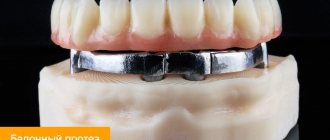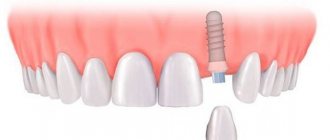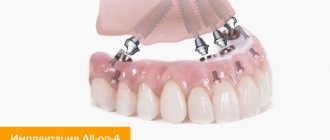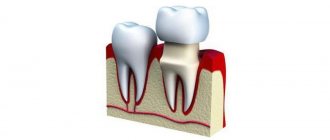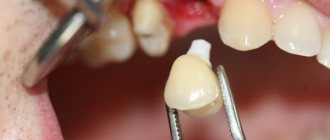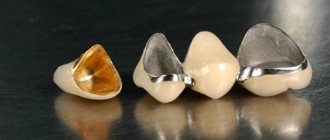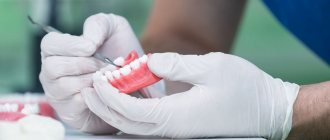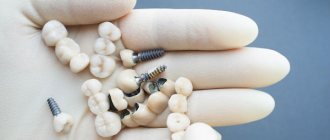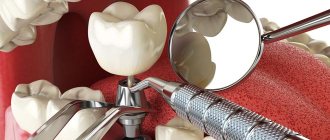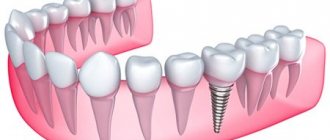613
Like any dental procedure, prosthetics with removable structures has a number of contraindications. Their number is insignificant compared to the prohibitions when fixing permanent systems, and is often temporary.
At the same time, neglect of such conditions can lead to the development of complications, the need to stop wearing artificial teeth and eliminate the resulting pathology.
General prohibitions
Immediately before prosthetics, the patient is examined, during which not only the condition of the oral cavity is assessed, but also the presence of chronic diseases that are an obstacle to the installation of an orthopedic structure is determined.
Situations that exclude the possibility of removable prosthetics:
- acute period of pathological processes localized in the respiratory organs, nasal passages, paranasal sinuses (colds, tonsillitis, sinusitis);
- inability to use local anesthetics;
- oncological neoplasms;
- sudden increase or decrease in blood pressure;
- general exhaustion of the body due to immunodeficiency;
- disturbance of psycho-emotional state and neurological diseases;
- pathologies of the hematopoietic system, in which a blood clotting disorder occurs;
- advanced form of diabetes mellitus and tuberculosis;
- if the allergen for the patient is metal or other components used in the manufacture of an orthopedic product;
- period of radiation therapy.
Pros and cons of silicone dentures, expert reviews on designs.
Come here to find out in which case a removable laminar denture is installed in case of partial absence of teeth.
At this address https://www.vash-dentist.ru/protezirovanie/semnyie-p/balochnyiy-na-implantatah.html we will calculate together the cost of installing a turnkey beam prosthesis on implants.
Indications and contraindications for installation
Prosthetics with clasp structures are carried out in the following cases:
- absence of frontal teeth on the upper or movable jaw;
- various dental defects;
- deep incisal overlap (complex anomaly of teeth closure);
- bruxism (teeth grinding);
- dystrophic disease of the tissues surrounding the unit (periodontal disease).
There are also categorical prohibitions on installation:
- allergic reactions to metal;
- lack of support units;
- shallow depth of the bottom of the movable jaw;
- low crown part of healthy teeth;
- diabetes;
- oncology;
- disruption of the cardiovascular system;
- dental inflammatory diseases;
- respiratory diseases.
The main reason for prosthetics with arched structures is the absence of 2 or more teeth in a row. They are placed when:
- lost units cannot be replaced by bridges due to a terminal defect or weak root system of the remaining masticatory elements;
- implantation is not possible due to cost or contraindications;
- there are extensive defects - one- and two-sided;
- in addition to partial adentia, periodontitis or periodontal disease was diagnosed.
Contraindications are:
- end defects;
- maintaining less than 6 teeth on each jaw - otherwise it is impossible to evenly distribute the chewing load and securely fix the structure;
- inflammatory processes in the root systems of supporting teeth - if the units are not cured, they will soon have to be removed and a new prosthesis made;
- any diseases of the oral mucosa - they are eliminated before prosthetics;
- severe curvature of the bite - open, cross;
- short frenulum of the tongue - in this case, plastic surgery is performed first;
- allergy to prosthetic materials;
- severe atrophy of the alveolar process and alveolar arch;
- increased tooth wear;
- small vestibule of the oral cavity.
The main indication for installing a partial denture is the absence of 2 or more adjacent teeth
Local restrictions
Sometimes situations arise when the dentist refuses to install a removable structure for the following reasons:
- Lack of proper oral care. This is explained by the fact that after installing a removable structure, it is necessary to carry out a number of hygienic measures, since otherwise the product may become unusable.
This situation necessitates free warranty service, but a problem of this nature leads to the failure of re-prosthetics because it was due to the patient’s fault. - Failure to follow medical instructions. At the preliminary stage, the orthopedist prescribes a set of measures for the sanitation of the oral cavity (carious cavities are eliminated, root canals are filled and tartar is removed).
If the patient refuses to perform these procedures, the doctor has the right to refuse the subsequent manufacture and installation of a removable structure. - Acute manifestations of dental diseases. The presence of pustular processes, ulcers and erosions with stomatitis and gingivitis necessitates complex therapy, after which prosthetics are permitted.
- Diseases of the bone tissue of the jaw row. Any type of fixed structure is not allowed to be installed when diagnosing the following pathologies - osteoporosis, osteomyelitis, granuloma or cystic compaction.
The meaning of psycho-emotional state
There are situations when the dentist advises postponing the installation of an orthopedic product due to the patient’s increased nervousness. This happens when the patient experiences fear of the discomfort that arises during a series of manipulations to install a removable structure.
In this case, the patient’s inappropriate behavior manifests itself as follows:
- the patient begins to interfere in the course of the treatment process (gives recommendations to the dentist);
- indicates the need to use anesthetics even in cases where the procedure is painless;
- requires speeding up the production of the structure.
The situation is much more serious if a person suffers from manifestations of dental phobia (odontophobia or dental phobia). This is an uncontrollable feeling of fear associated with visiting a dentist, or the manipulations he performs with a drill.
In contrast to ordinary fear, the patient experiences uncontrollable hysteria, sometimes with loss of consciousness. In addition, in some cases there is an abrupt increase in pressure and body temperature.
This development of the situation requires a delicate approach. A person is recommended to undergo auto-training and learn to control his mental behavior.
You need to know that an important point before performing any dental procedures is the dialogue between the doctor and the patient. The doctor must explain how safe it will be to perform a particular manipulation, while simultaneously listening to the patient’s concerns.
Let's decide together what to do when a denture rubs and whether it always needs to be replaced.
In this post, find out what the T Crystal removable denture looks like.
Here https://www.vash-dentist.ru/protezirovanie/semnyie-p/primenenie-uslovno.html you will find a detailed description of a conditionally removable denture on implants.
Possible complications
If during the manufacturing and installation of an orthopedic product the technology was not violated, and the oral cavity was fully prepared, then the possibility of complications developing is minimized. How complications appear after removable prosthetics.
| Number in order | Type of complication | Short description | Troubleshooting method |
| 1 | Rubbing | The patient feels the presence of a foreign body in the oral cavity, due to which the secretion of salivary fluid increases. There is a feeling of pain while eating. | Uncomfortable sensations can be observed for 2 weeks (during adaptation). If after this period the negative symptoms do not go away, you need to contact your dentist to adjust the removable structure. |
| 2 | Prosthetic type of stomatitis | Hyperemia of the oral mucosa is accompanied by the appearance of small ulcers and erosions. Violation of trophic processes causes the formation of bedsores. | After contacting the doctor, therapy will be prescribed using antiseptic mouth rinses. If necessary, antibiotics and drugs that accelerate the regeneration of gum tissue are prescribed. |
| 3 | Development of carious cavities or pulpitis | Improper hygiene or food particles getting under the coronal part of the supporting unit causes the development of caries or pulpitis. This situation causes paroxysmal pain, accompanied by bleeding gums and bad breath. | If caries or pulpitis has progressed to an advanced form, then it becomes necessary to remove the crown on the supporting tooth, followed by treatment. |
| 4 | Allergy | Despite the use of hypoallergenic materials, there are sometimes cases when the patient’s body reacts to them with the following symptoms: rashes like urticaria; mucous membranes become bright red; the capillary pattern intensifies on the white part of the eye; The presence of dry mouth and burning tongue is explained by inflammation of the salivary glands. | After removing the denture, you must immediately contact a dental clinic. Re-installation of an orthopedic product involves the use of other materials. |
| 5 | Galvanic syndrome | The presence of metal in an orthopedic structure causes the appearance of galvanic currents. In this case, saliva becomes an electrolyte. The patient experiences discomfort when eating, he has a taste of metal and bitterness in his mouth. Against the background of general malaise, headaches appear and difficulty falling asleep occurs. | The problem can only be eliminated by reprosthetics using other types of alloys. |
| 6 | Loosening the fixation | The patient notes a displacement of the structure in the oral cavity. It no longer adheres tightly to the soft tissues of the gums, which leads to spontaneous loss while eating or talking. | In most cases, using dental glue like Corega helps. |
Detailed description of the laboratory stage of prosthesis manufacturing
Making a clasp device is quite difficult. Labor-intensive work is divided into two stages: clinical and laboratory.
Clinical stage
Any type of prosthetics requires a mandatory visit to the dentist and preparatory measures.
To complete the clinical stage, 6 visits to a specialist will be required:
- diagnostic procedures, drawing up a treatment plan;
- preparation of reference specimens (treatment, preparation if necessary);
- taking impressions from the jaws (2 copies from each jaw);
- making a model of the future product;
- fitting session, correction;
- final installation of the product in the oral cavity.
Laboratory stage
After the impressions are delivered to the laboratory, the stage of manufacturing the clasp device begins. It includes the following manipulations:
- Making a diagnostic model from marble plaster. This will make it possible to create an accurate individual device for a specific clinical case, taking into account the smallest details of the structure of the oral cavity.
- Accurate characterization of occlusion in different planes.
- The stability of the supporting units under the influence of loads received from the manufactured device is determined.
- Drawing a picture (drawing, graphics) of the future product on a plaster model.
- Simulation of the preparation process of abutment units using a plaster replica.
- Formation of a wax copy of the base and future frame according to the finished drawing.
- The casting process of making a frame from a created wax copy.
- Installation of artificial specimens on wax rollers, their formation on a plaster copy.
- Placing the wax apparatus with units in a special plaster mold. Melting of wax and its subsequent removal. Pouring acrylic plastic. Connecting all parts of the structure to each other.
- Delivery of the finished product to the orthopedist.
The video shows the stages of making a clasp prosthesis.
There are the following stages of manufacturing a clasp prosthesis:
- Clinical (manufacturing).
- Laboratory.
- Clinical (prosthetics).
Next, we will consider in detail all the stages of making a clasp prosthesis.
The patient must visit the dentist several times.
- First, a comprehensive examination is carried out and an individual treatment plan is drawn up.
- Then the supporting teeth are selected, examined, if necessary, treated and ground (if locking and telescopic models are used). The choice of supporting teeth is a very important stage, as they may not withstand the load when wearing a prosthesis and there is a risk of losing them.
- After this, an impression of the teeth is made. To make a high-quality prosthesis, you need to make two impressions.
- When the dental impression is ready, a model of the prosthesis is made from it.
- Then you need to try it on and adjust it, taking into account the results of the fitting.
- When all steps are completed, the denture is finally installed in the patient’s mouth.
- The first step is to make a diagnostic model. For this purpose, durable plaster is used, thanks to which it is possible to make a model that is individually suitable for each client. At this stage, all details of the structure of the patient’s oral cavity are taken into account.
- At the second stage, you need to determine the nature of the bite, and also study the location of the lower and upper jaws in three perpendicular planes.
- Next, you should carefully examine the supporting teeth and determine the level of load that they can withstand.
- Next, a graphic image of the clasp prosthesis and its drawing are applied to the resulting diagnostic model.
- Then, on the same plaster model, the process of turning selected abutment teeth is simulated, that is, a control preparation is carried out. This is exactly how the process of grinding natural supporting teeth will then be carried out.
- According to the drawings, a model of the future prosthesis frame is formed from wax on a diagnostic model.
- Using the resulting wax model, the frame of the clasp prosthesis is cast. The wax blank is removed from the plaster model and placed in a fireproof mold. There, under the influence of temperature, the wax is melted and acrylic plastic is poured in its place. Casting can be done without removing the wax blank from the diagnostic model. In this way, it is possible to avoid possible deformation of the wax blank, and the finished design will be more accurate. The wax is removed from the resulting frame, and it is ground and polished. Then it is tried on in the patient's mouth.
- At this stage, artificial teeth are installed on wax rollers.
- Then the resulting wax structure is placed in a plaster mold, from there the wax is melted and removed, and acrylic plastic is poured in its place. In this way, the metal and plastic parts of the clasp prosthesis are connected.
- At the final stage, the finished prosthesis is handed over to the dentist for installation in the patient’s oral cavity.
Correctly making a clasp prosthesis can only be done in the presence of a special laboratory. Let's take a closer look at two methods of constructing a structure:
- In the first method, the structure is cast by removing the blank from the plaster model. The workpiece is placed in a fireproof mask, where the wax is melted, and molten metal is placed in its place.
- In the second method, the workpiece is not removed from the plaster model. Thus, the future prosthesis will not be deformed, and wearing it will be more comfortable.
Cast clasp dentures are very light and easy to manufacture, so the patient does not need additional time to get used to them. They immediately fit comfortably in the oral cavity and do not cause inconvenience.
The creation of clasp dentures includes 2 stages: clinical (in the doctor’s office) and laboratory. They are interconnected and intertwined at every stage.
The step-by-step manufacturing process is as follows:
- Anamnesis collection. The type and scale of the defect are diagnosed, possible dental and periodontal diseases are identified using X-ray photos, the type of bite is determined, and the allergic status is clarified.
- Determination of the type of prosthesis. Choose the best price and the most suitable for a specific situation.
- Preparation of supporting teeth and prosthetic bed. Eliminate all identified inflammatory processes: caries, pulpitis, periodontitis, stomatitis, etc. In the case of installing clasp dentures of a locking or telescopic type, the supporting teeth are ground and covered with crowns. This is the only stage that may be painful, so it is performed under local anesthesia.
- Taking impressions. Plaster impressions of both jaws are made.
- Direct production. Based on the impressions, the dental technician first makes a drawing of the future prosthesis, and then a wax model of the arch. Then, based on the wax model, a metal frame is cast, onto which temporary wax bases and artificial teeth are attached.
- First fitting. The semi-finished structure is tried on and inaccuracies, tightness of fit and fastenings are identified. Then the prosthesis is sent for revision to the laboratory, where it is corrected and the final version is made.
- Final fitting and fixation. The finished product is tried on for the last time and secured in the oral cavity. During the same visit, the doctor explains how to remove, put on and care for the prosthesis.
We invite you to familiarize yourself with Dentures budget option
Dentures are made according to individual impressions
From the first visit to the clinic to the installation of the structure, an average of 3-4 weeks passes. This time increases if long-term preparation is needed - for example, in the presence of inflammatory diseases of the oral cavity. Also, the production time is extended if the prosthesis is made inaccurate, and it is necessary to correct it or cast a new one.
Recommendations for quick adaptation
Removable prosthetics will be used in dental practice for a long time due to the reasonable price and speed of production of the product. In addition, most contraindications can be eliminated by providing proper dental care and performing treatment procedures.
When getting used to dentures, there are 3 phases.
Location phase
It is characterized by focusing attention on the orthopedic product, since the structure is perceived as a foreign object. In this case, the patient appears:
- diction defects (a lisp appears);
- excess tension in the cheeks and lips occurs;
- gagging appears.
Partial braking
After a five-day period, tactile sensations return to normal, and almost all negative symptoms are eliminated.
Full braking phase
Its duration ranges from 5 to 33 days. During this period, a person experiences discomfort in the absence of a prosthesis in the oral cavity.
To speed up the adaptation to an orthopedic product, practitioners recommend following the following rules:
- for a two-week period, remove the prosthesis only for hygienic measures;
- to restore diction, it is recommended to read aloud (4 hours daily);
- the first days do not load the front incisors;
- the food should not be rough; the dishes consumed should be cut into small pieces;
- be sure to visit the dentist 3 days after installing the product;
- For better fixation in the mouth, use a fixing cream (Corega, Protefix).
Price
The price for a similar product has a wide range, which is determined by:
- Preliminary dental treatment before installing dentures;
- The material from which the prosthesis is made;
- Installation method.
The cost of clasp prostheses in the Russian Federation ranges from 15 to 20 thousand rubles. The splinting method of prosthetics will require 20 thousand rubles. The use of attachments will cost the client about 50,000 rubles, but a one-sided clasp prosthesis will cost no more than 35,000.
Clasp dentures are much more comfortable and effective than their competitors. Only implants can compare with them in quality, but their price will be several times higher, so this method is not available to everyone.
Alternative Methods
The implantation of dental implants (as an alternative method) allows you to install removable dentures. In this case, artificial units will serve as a support for the orthopedic structure.
Also, with complete edentia, it is possible to restore the integrity of the dentition by implanting 14 implants for each jaw row.
It is important to note that this technology, despite its high degree of reliability, is an expensive procedure and is used in rare cases.
Let's consider two methods that are a worthy alternative to removable prosthetics.
Bridges on implants
All-on-4 and All-on-6 are techniques that allow fixing a fixed prosthesis on 4 or 6 implants. The All-on-6 technique is especially popular. In this case, 6 artificial roots allow you to evenly distribute the load on the jaw row.
Removable design on implants
To carry out this technique, it is enough to implant 2 or 3 titanium rods. Ball-shaped abutments are installed on them, or a beam structure is used.
The advantage of this product is quick adaptation (no nausea or sensation of a foreign body in the mouth) and comfortable wearing.
Compared to removable structures, artificial roots made of titanium have the following advantages:
- the prosthesis is perfectly fixed; fast adaptation;
- long service life with proper care;
- uniform distribution of load during the act of chewing;
- high aesthetic indicators.
The relative disadvantage is:
- there are contraindications for endocrine diseases (diabetes mellitus), as well as diseases in which blood clotting is impaired;
- the procedure cannot be performed if there is a deficiency of bone tissue, which necessitates osteoplasty;
- long implant healing (from 4 to 6 months);
- the possibility of rejection cannot be ruled out;
- high cost of the procedure.
In the video, the dentist will talk in more detail about the alternative to removable dentures.
The concept of clasp dentures
Clasp prosthetics is the most modern and convenient. If you study the photo of clasp dentures, it becomes clear how miniature and neat they are. Such designs bring a minimum of discomfort, are practically not felt in the mouth, and do not change speech. A correctly fitted clasp denture is absolutely invisible to others, and your smile becomes perfectly straight. In addition, the structures are made of strong and high-quality materials, which significantly extends their service life.
Translated from German, “bugel” is translated as “arc,” which determines its appearance and structure. The basis of clasp dentures is an arch made of a special metal material. When restoring the upper dentition, the thin main part of the clasp denture has a saddle shape.
In addition to the arch, dentures consist of crowns, acrylic artificial gums and a fastening system. Clasp crowns look like real teeth, giving your smile a natural appearance.
Reviews
Most people who have experienced the installation of removable orthopedic products note that the inconvenience practically disappears after 10 days of continuous wearing. In addition, they have a low cost, which is why their installation can be performed by people with limited material income (people of retirement age).
You can leave your opinions and reviews in this place of this article.
If you find an error, please select a piece of text and press Ctrl+Enter.
Tags prosthetics removable dentures
Did you like the article? stay tuned
Previous article
Types of support-retaining clasps in prosthetics
Next article
What are the best crowns to put on dental implants and why?
